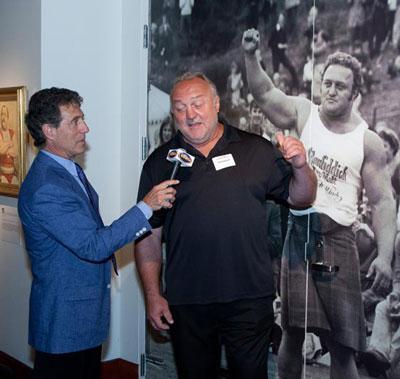The reception to celebrate the official opening of the Joe and Betty Weider Museum of Physical Culture was private, and only invited guests were allowed to take photographs or to videotape the occasion. Almost 200 professional photographs—taken by several leading photographers including John Balik, the publisher and editor of Iron Man magazine and Robert Gardner, a longtime fashion and sport photographer who also worked for the Weider magazines for decades, are already up on our website [editor’s note: we are working to re-create this page]. As for moving images, the main video team was from MUSL, a group intent on creating a cable channel focusing on all aspects of physical culture. (Their website is www.musltv.com.)[editor’s note: musltv.com is no longer in existence.]

Over the past year or so, we’ve had a number of meetings with the leadership of MUSL, including Jacob Arback, the CEO, and Robb Weller, the Executive Vice President for Programing and Production. We’ve been very impressed by their track record—as has the brain trust from the Arnold Sports Festival–and so when MUSL expressed an interest in attending the Weider Museum opening we enthusiastically invited them to come and also to tape the evening for posterity. They did this by hiring a local crew and, under Weller’s direction, by interviewing the guests, taping the speeches, and in general capturing the spirit and feel of the occasion. Robb has had a long television career as an executive as well as behind the mic, and he handled the interviews.
Down the road, once MUSL is on the air 24-7—which should happen sometime next year—several uses will probably be made of the evening’s taping, but in the meantime we decided to ask Eric Williams, an Austin-based producer and film editor who worked for MUSL that night, to edit the raw footage into a documentary of between 20 and 25 minutes. We believe the resulting documentary will go a long way toward helping people to better understand how the 225 or so guests we had that night reacted to what they saw at the Stark Center and inside the Weider Museum. The video has been embedded at the bottom of this post.
From what can be gathered from the documentary, it seems to have been the case that our guests—a great majority of whom had never visited the facility before—were surprised at the scope of the Stark Center and by the size and richness of the Weider Museum and the photographic exhibition that was on display. The interviews make this plain and also emphasize how pleased the guests were to fully understand that the field in which they carved out a prominent place for themselves had given birth to a place at which serious students of the iron game and health promotion could study—a place where the “papers” and photos and artifacts of the major players in the field could be collected and saved for future generations. That this reaction was genuine can be seen from the fact that quite a number of our guests have either sent artifacts from their personal collections or sent checks to help us with our significant and ongoing operating expenses.
It was also apparent that our visitors felt an overwhelming gratitude to Joe and Betty Weider for becoming the first significant financial backers of our effort to create a combined research library and museum in a public facility. Well before there was a Stark Center, Joe directed the Weider Foundation to provide a million dollars toward this effort. I made it clear in my remarks that night and in things I’ve written that had Joe not done what he did in 2004 the University may never have given us an opportunity to raise the five and a half million more it took to build out the bare shell we were given.
But the gratitude our guests felt for Joe and Betty went far, far beyond the Weiders’ contributions to the Stark Center and the Weider Museum as significant as those were ($2,000,000 as well as almost all of their iron game art). The guests’ gratitude was primarily based on the decades during which Joe and Betty and Ben Weider led the fight to bring the field of resistance training out of the relative handful of the usually dark and primitive gyms of the past and into the health clubs, the hospitals, the public schools, the colleges, the retirement homes, and the armed forces of the world we have today. Many of the guests we had in Austin that night were among the game’s most prominent people—lifters, bodybuilders, strongmen, administrators, coaches, and manufacturers—and they know how long and hard Joe worked to bring physical culture into the beating heart of popular culture. These people watched him do it and helped him do it. And it was that experience and that knowledge which led to the outpouring of gratitude that flowed over this patriarch who sat smiling quietly as the guests crowded around him to shake his hand and to tell him how much he had meant to them and to the game which has made us all.



Leave a Reply